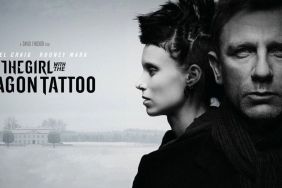
Dubbed “the feel bad movie of Christmas,” David Fincher‘s The Girl with the Dragon Tattoo lives up to its slogan and its very hard R-rating with a rape scene uncomfortable enough to make you wonder how the MPAA let them slide without cutting more, revenge for that rape that will leave you equally chilled and the dull slap of a golf club to the face that sends teeth rattling to the floor. Fincher has undoubtedly embraced the dark and bleak nature of Stieg Larsson‘s novel and now it depends on whether or not you are ready to endure what he’s put together for you, though I dare you not to be absolutely entranced by Rooney Mara as the film’s titular character.
Larsson’s “Millennium Series” has been translated into dozens of languages and sold millions of copies all across the globe. The three books in the series were already adapted into a popular Swedish miniseries that was cut down to theatrical length and released in the States only a year ago. These facts taken into consideration, Fincher and screenwriter Steven Zaillian needed to face the reality that fans of the book and original Swedish adaptations would already be looking on with critical eyes, wondering why another adaptation was necessary and what was left to be told? After seeing The Girl with the Dragon Tattoo I can say there isn’t anything more to be told as nothing new is introduced to the story you’ve already seen and read, though a few cuts are made here and there to keep the running time manageable. So, with nothing new to tell, the key was in the telling.
Wasting little time in making clear his intentions, Fincher briefly introduces the audience to the aging Swedish industrial businessman Henrik Vanger (Christopher Plummer). Having just received another pressed flower on his birthday, a reminder presumed to have been sent by whoever killed his niece 40 years earlier, Henrik realizes he can no longer allow her memory or her killer to torment him like this. He hangs up the phone and the music shifts into something of a Nine Inch Nails interpretation of a James Bond title sequence. Carbon fiber imagery begins dripping as oily hands crush soft, anonymous faces and dragons spew fire in a plastic cacophony energized by an industrial remix of Led Zeppelin’s “Immigrant Song”. It’s entirely out of place, but if it’s your kind of thing, as it is mine, it certainly gets you in the mood to watch a movie.
As the title imagery fades we are introduced to recently disgraced journalist and editor at Millennium Magazine, Mikael Blomkvist (Daniel Craig). Blomkvist has just seen his name dragged through the mud thanks to an article he wrote that he later learns was fueled by a bogus source, allowing a dirty businessman to gain the upper hand and sue him for libel. In an attempt to ensure the magazine doesn’t go down with him, he fires himself, a decision that’s met with another opportunity.
Henrik Vanger’s determination to find his niece’s killer before the torment kills him is too much to bear. For forty years he’s essentially tried all on his own and now he looks to Blomkvist, a man with plenty of time, nothing to lose and a soft spot Vanger knows he can use to his advantage. Being a businessman in the area for many years, Vanger not only promises Blomkvist payment no matter what he finds, but information that will allow him to finally nail the dirty businessman that eluded him. Blomkvist accepts and the journey begins.
The circumstances under which they meet are changed from the source material, but soon entering into the picture is Lisbeth Salander (Mara), the titular “girl with the dragon tattoo”, a descriptor that is more cosmetic than anything else as Salander’s character is hardly determined by her tattoos or the punk rock clothes on her back (though I absolutely loved a t-shirt she’s seen wearing more than once that reads “F**k You You F**king F**k”). Lisbeth’s story is more complex than material things and in the first of Larsson’s trilogy of stories, The Girl with the Dragon Tattoo is the least revealing.
When it comes to Lisbeth, this story introduces us to what she has become rather than where she comes from. We know she’s been assigned a guardian, we know she’s a hacker and we know she trusts no one. These three traits weigh heavily on her involvement in the story as she soon comes to be Blomkvist’s assistant in the search for the killer and their relationship becomes the underlying focal point of the film.
Having read the first two books in the Millennium trilogy and seen the three previous Swedish adaptations, the one thing that has always bothered me about this introductory story is how unimportant the mystery of the missing person is and yet how much time is devoted to it (though I’m sure others would argue it’s pivotal when exploring Lisbeth’s character). Unfortunately, there isn’t any way of getting around this, but Fincher and Zaillian do their best to make sure the unique relationship between Lisbeth and Mikael is what the audience walks away thinking about, especially since the mystery of the missing girl is handled with a quick and simple stroke. Rightfully so if you ask me, as the final 15 minutes of this film are what truly won me over more than anything that came before them.
I give a large part of the credit to this film’s success to Mara who opens herself up in every way to Lisbeth and, just as importantly, has the perfect look for the character. At once ferocious, determined and sometimes frightening, Mara also gives Lisbeth a sense of fragility. In an instant she can be made to look almost like a child, adding a tremendous weight to the actions seen on screen.
Circumstances make Lisbeth an easy character to sympathize with, but a few choice moments such as when she asks, “Can I kill him?” and a longing glance in the snowy distance sum up the character more than any piece of clothing, piercing or tattoo. This isn’t to disrespect costume designer Trish Summerville‘s efforts or the makeup department who softened up Mara with pale white skin, smooth features and jet black hair offering contradictions that seemingly capture different meaning with each changing glance. All of this aided the overall effect the character had, though I was fond of the fact Fincher captured the idea this was Lisbeth’s story as much as the Coen brothers realized True Grit was Mattie’s.
Adding to the atmosphere, Fincher has again brought in The Social Network composers Trent Reznor and Atticus Ross for the score, giving it a seething electronic vibe and one that is certainly more present and, at times, noticeable than it was with Social Network. Early on especially, there are moments when there is too much music layered over the feature and too many noises that have little to nothing to do with what’s on screen, but in most instances it is a perfect complement to the tortured and tormented plot.
Boiled down, this would appear to be the best adaptation of Larsson’s source material you could come to. In my opinion the story has always lacked focus, placing too much emphasis on the mystery rather than an evolving exploration of the title character. Fincher and Zaillian seem to understand that and have done their best with the story they had and, I hope, have created an opportunity for them to explore the more intriguing second book in the series, “The Girl Who Played with Fire,” where Lisbeth’s story truly begins to take shape.
I find it hard to picture Fincher directing a three-film franchise, but if there was ever one that suits his style and would benefit from his sensibilities it’s this one. While this film didn’t completely blow me away I find myself longing to watch it again, which I will the first chance I get.








